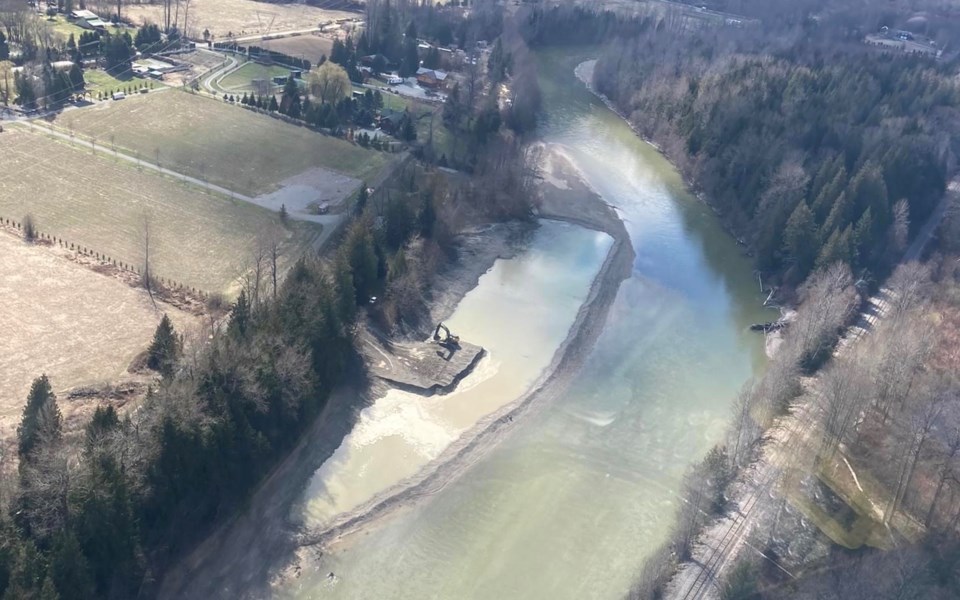For the past 75 years, the Pemberton Valley Dyking District (PVDD) has managed the most extensive dike system in the province outside the Lower Mainland, and helped protect Spud Valley from numerous flooding events, big and small. However, the days of the PVDD may soon come to an end, as the provincial government aims to end the last diking improvement districts in the province.
On May 18, the Squamish-Lillooet Regional District (SLRD) issued a request for proposals (RFP) to have the governance of the PVDD reviewed, and the resulting report will outline the potential fate of the improvement district.
According to an SLRD spokesperson, the regional district initiated the RFP at the request of the province, and the decision involved not just the SLRD but all members of the Pemberton Valley Emergency Management Committee (PVEMC), which includes the SLRD, Lil’wat Nation, the Village of Pemberton and the PVDD.
“Because it is a regional service for the Village of Pemberton (VOP), SLRD Electoral Area C and Lil’wat Nation, the Committee agreed, unanimously, that the SLRD should lead the RFP process, but this is a collaborative effort and not an SLRD-specific project,” the spokesperson said in an email.
The end of the PVDD as a tax-funded organization has been on the horizon since 2006, when the provincial government officially began phasing out improvement districts across B.C. However, the creation of new improvement districts ended much earlier, in 1995, with most improvement districts absorbed into regional districts or joining nearby municipalities.
According to PVDD operations and maintenance manager Kevin Clark, most improvement districts are tiny entities that supply water and sewer services, making it logical to incorporate them into larger polities like regional districts. However, as the province has gradually dismantled the improvement system, it has resulted in red tape and funding constraints for the PVDD.
“They took our ability to apply for direct government funding away,” Clark said. “So that's why, when we go for funding now, we have to go through the Village of Pemberton or the Regional District to get money to do diking projects.”
But with that change came unintended consequences, Clark said. With very few diking districts left, the PVDD “ended up just getting lumped in,” he said.
“So [the Ministry of Municipal Affairs has] spent the last two years going back and forth over where the PVDD should land,” Clark said. “Should we join with the village, should we join with the regional district, or should we do something else? Is there another option that none of us have thought of yet?"
The service and governance needs assessment will highlight the pros and cons of merging the PVDD with other levels of government. Following that, the parties involved will decide what is the best approach moving toward.
Clark is open-minded to the governance review, but wants taxpayers to have a chance to provide their opinion on the future of the PVDD.
“The public needs to be educated on what joining the regional district or what joining the Village [of Pemberton] or what staying as we are, what that means for their dollar,” he said. “Because as a taxpayer in this town, you should have a say on what [happens]. Every year you pay your diking taxes, you should also have a say on our future.”
The PVDD currently manages about 44 kilometres of dikes, 25 km of drainage ditches, 30-plus culverts and flap gates, 16 km of bank armouring in the valley, and does annual sediment management on significant rivers and creeks in the area, such as the Lillooet River, to manage freshet.
With a small staff of two full-time workers, a summer student and one part-time employee, the improvement district is small but mighty, and is financed through grants from higher levels of government and through a local diking tax.
The current dike tax rate is set at $.57 per $1,000 in residential assessed value and $1.40 for commercial properties, which works out to about $625 for an average single-family residential property worth $1.1 million.
As property values rise in the Pemberton Valley, the PVDD brings in more tax revenue. In 2021, it brought in $1,001,819 in dike taxes compared to $857,578 in 2020, while government transfers increased from $687,005 in 2020 to $1,457,382 in 2021.
In the case the PVDD joins with the regional district, SLRD chair Jen Ford expects that it could be funded through a local service area similar to how landslide mitigation structures at Lillooet Lake Estates are being paid for, or through a joint funding model like in the case of the Pemberton Recreation Centre.
“I guess we don't really know until we know what the structure would be, but we have lots of service areas that only the people that would interact with that diking would pay into, so it wouldn't become a general government function like emergency services,” Ford said.
Read more at pvdd.ca.




